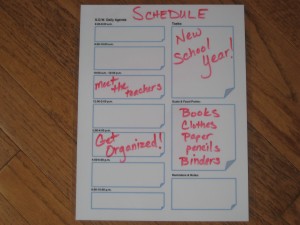It’s that time of year. The time when parents scurry around with lists of school supplies, go shopping for school clothes, and try to get organized for the new school year. The back to school season can be exciting as kids head to new classes and college students make the trip to campus, but it can also be a time of anxiety as we transition to a new schedule and adjust to all the changes.
One way to make the new school year go smoothly is to organize your schedule with a clear and simple system. When juggling a busy schedule, it is best to create solid routines, keeping us on track and moving seamlessly between tasks and activities. Here’s how I organize my family’s school year schedule to keep each of us headed in the right direction at the right time.
Master Schedule: First, I create a master weekly schedule. A simple calendar template allows me to enter standing appointments or activities such as tutoring sessions or music lessons. I can also create blocks of time for regular tasks such as homework. Once my master schedule is set, I print a copy for each member of the family. This schedule will serve as a guide so everyone knows what’s going on. Single appointments can easily be added in the template (and reprinted) or simply handwritten in the schedule for the week.
Regular Routines: Next, I develop routines to guide me and my family through a series of activities in a prescribed order. For instance, instead of trying to schedule each aspect of what needs to be done in the morning, I create a morning routine that includes items like exercise, showering, getting dressed, making beds, breakfast, and more. Focusing on each item makes the list seem long and overwhelming. By creating a morning routine, I develop a habit of doing each item one after the other without much thought. Once a routine becomes an established habit, each task in the routine requires less thought to get it done.
Order of Operations: Finally, I establish a plan for the overall order of the day and the work that needs to be accomplished. In math, we follow an order of operations so we know how to solve complex equations and arrive at an accurate solution. Similarly, creating a general order for what needs to be done simplifies complex work and scheduling issues because it automatically prioritizes and orders our tasks and activities. One way this has worked especially well for my kids is in setting an order for homework assignments. We have a grid that identifies what each child needs to do first, second, third, and so on until each subject has been completed.
We can minimize the stress of a busy schedule by putting some simple organizers in place to manage our time and our tasks. Our families benefit from knowing what comes next and routines help us get more done with less energy for each task.
